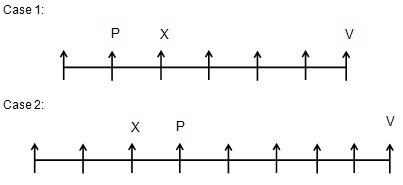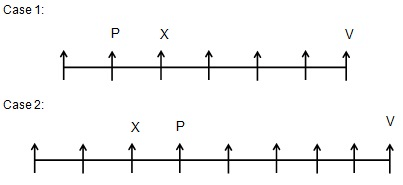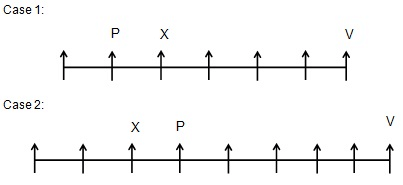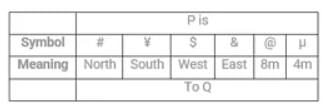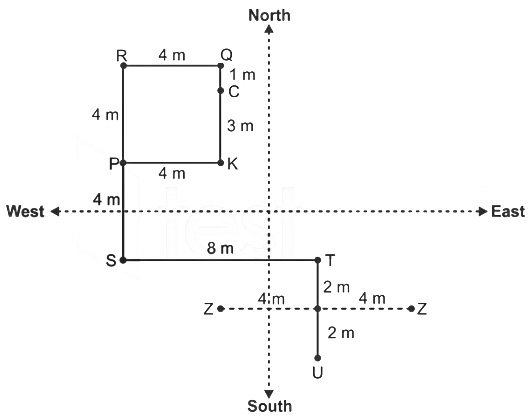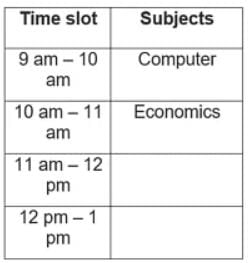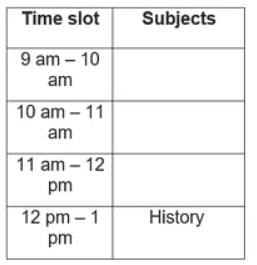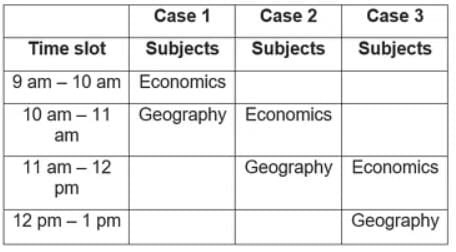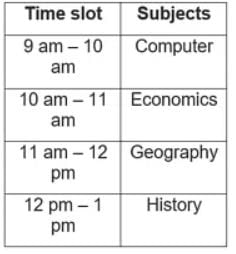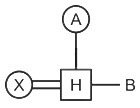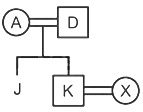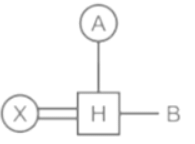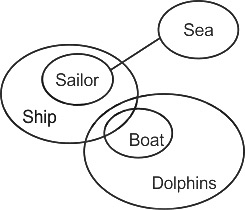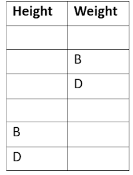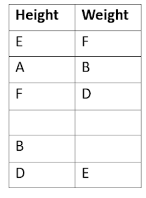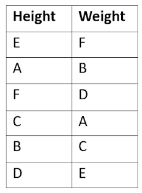IBPS Clerk Mains Mock Test - 9 - Bank Exams MCQ
30 Questions MCQ Test - IBPS Clerk Mains Mock Test - 9
How many meaningful English words can be formed, starting with S, with the second, the fourth, the fifth and the eighth letters of the word PERISHED, using each letter only once in each word? (To be counted from left)
Directions: In the question below are given three statements followed by three conclusions numbered I, II and III. You have to take the given statements to be true even if they seem to be at variance with commonly known facts. Read all the conclusions and then decide which of the given conclusions logically follows from the given statements disregarding commonly known facts.
Statements:
All water is the pond.
Some pond is the river.
No river is the tree.
All trees are jungle.
Conclusions:
I. Some water is the river.
II. Some pond is not the tree.
III. All water being jungle is possibility.
Directions: Read the following information carefully and answer the question given below.
There are some persons who are sitting in a row and facing north. The number of persons who sit on the left side of E is one less than the number of persons who sit on the right side of E. There are more than two persons between Q and T who sit to the left of W. Q sits on the left side of X. F does not sit on the extreme ends. There are four persons between P and V. There are two persons between R and W. Neither N nor M is the neighbor of X. There are four persons between W and Z who do not sit to the left of E. There are only two persons who sit to the left of X. There is one person between E and P. E is not the immediate neighbor of X. P is the immediate neighbor of X.
How many persons sit between Q and W?
Directions: Read the following information carefully and answer the question given below.
There are some persons who are sitting in a row and facing north. The number of persons who sit on the left side of E is one less than the number of persons who sit on the right side of E. There are more than two persons between Q and T who sit to the left of W. Q sits on the left side of X. F does not sit on the extreme ends. There are four persons between P and V. There are two persons between R and W. Neither N nor M is the neighbor of X. There are four persons between W and Z who do not sit to the left of E. There are only two persons who sit to the left of X. There is one person between E and P. E is not the immediate neighbor of X. P is the immediate neighbor of X.
Four of the following are alike in a certain way and hence form a group. Which of the following does not belong to that group?
Directions: Read the following information carefully and answer the question given below.
There are some persons who are sitting in a row and facing north. The number of persons who sit on the left side of E is one less than the number of persons who sit on the right side of E. There are more than two persons between Q and T who sit to the left of W. Q sits on the left side of X. F does not sit on the extreme ends. There are four persons between P and V. There are two persons between R and W. Neither N nor M is the neighbor of X. There are four persons between W and Z who do not sit to the left of E. There are only two persons who sit to the left of X. There is one person between E and P. E is not the immediate neighbor of X. P is the immediate neighbor of X.
How many persons sit between X and Z?
Directions: Read the following information carefully and answer the question given below.
There are some persons who are sitting in a row and facing north. The number of persons who sit on the left side of E is one less than the number of persons who sit on the right side of E. There are more than two persons between Q and T who sit to the left of W. Q sits on the left side of X. F does not sit on the extreme ends. There are four persons between P and V. There are two persons between R and W. Neither N nor M is the neighbor of X. There are four persons between W and Z who do not sit to the left of E. There are only two persons who sit to the left of X. There is one person between E and P. E is not the immediate neighbor of X. P is the immediate neighbor of X.
Who among the following sits on the immediate left of V?
Directions: Read the following information carefully and answer the question given below.
There are some persons who are sitting in a row and facing north. The number of persons who sit on the left side of E is one less than the number of persons who sit on the right side of E. There are more than two persons between Q and T who sit to the left of W. Q sits on the left side of X. F does not sit on the extreme ends. There are four persons between P and V. There are two persons between R and W. Neither N nor M is the neighbor of X. There are four persons between W and Z who do not sit to the left of E. There are only two persons who sit to the left of X. There is one person between E and P. E is not the immediate neighbor of X. P is the immediate neighbor of X.
The position of how many persons are not known?
Direction: Study the following information carefully and answer the following questions.
Nine Students A, C, E, G, I, K, M, O and Q are standing in line for a 100-meter race facing the North direction but not in the same order and the distance between them is equal. They all have some sticks with them that is 1, 2, 3, 4, 5, 6, 7, 8 and 9.
More than 5 students stand between A and I. The sum of sticks of A and I is 3. A is standing just near K who has 5 sticks. There are three students standing between G and E. Difference between the Sticks of G and E is 3 and E has a stick which is a prime number. The number of students standing between K and O is exactly the same as the number of students standing between O and Q. O is standing to the left of Q. Difference between the sticks of M and O is 2 and both have an even number of sticks. M has less sticks than O. M is not adjacent to G. G is standing immediately left of Q. E is standing third from one of the ends. C has sticks which is one by third of the sticks Q has.
Who stand 5th to the right of A?
Direction: Study the following information carefully and answer the following questions.
Nine Students A, C, E, G, I, K, M, O and Q are standing in line for a 100-meter race facing the North direction but not in the same order and the distance between them is equal. They all have some sticks with them that is 1, 2, 3, 4, 5, 6, 7, 8 and 9.
More than 5 students stand between A and I. The sum of sticks of A and I is 3. A is standing just near K who has 5 sticks. There are three students standing between G and E. Difference between the Sticks of G and E is 3 and E has a stick which is a prime number. The number of students standing between K and O is exactly the same as the number of students standing between O and Q. O is standing to the left of Q. Difference between the sticks of M and O is 2 and both have an even number of sticks. M has less sticks than O. M is not adjacent to G. G is standing immediately left of Q. E is standing third from one of the ends. C has sticks which is one by third of the sticks Q has.
How many student standing between G and Q?
Direction: Study the following information carefully and answer the following questions.
Nine Students A, C, E, G, I, K, M, O and Q are standing in line for a 100-meter race facing the North direction but not in the same order and the distance between them is equal. They all have some sticks with them that is 1, 2, 3, 4, 5, 6, 7, 8 and 9.
More than 5 students stand between A and I. The sum of sticks of A and I is 3. A is standing just near K who has 5 sticks. There are three students standing between G and E. Difference between the Sticks of G and E is 3 and E has a stick which is a prime number. The number of students standing between K and O is exactly the same as the number of students standing between O and Q. O is standing to the left of Q. Difference between the sticks of M and O is 2 and both have an even number of sticks. M has less sticks than O. M is not adjacent to G. G is standing immediately left of Q. E is standing third from one of the ends. C has sticks which is one by third of the sticks Q has.
Who is standing third to the left C?
Direction: Study the following information carefully and answer the following questions.
Nine Students A, C, E, G, I, K, M, O and Q are standing in line for a 100-meter race facing the North direction but not in the same order and the distance between them is equal. They all have some sticks with them that is 1, 2, 3, 4, 5, 6, 7, 8 and 9.
More than 5 students stand between A and I. The sum of sticks of A and I is 3. A is standing just near K who has 5 sticks. There are three students standing between G and E. Difference between the Sticks of G and E is 3 and E has a stick which is a prime number. The number of students standing between K and O is exactly the same as the number of students standing between O and Q. O is standing to the left of Q. Difference between the sticks of M and O is 2 and both have an even number of sticks. M has less sticks than O. M is not adjacent to G. G is standing immediately left of Q. E is standing third from one of the ends. C has sticks which is one by third of the sticks Q has.
How many sticks does Q has?
Direction: Study the following information carefully and answer the following questions.
Nine Students A, C, E, G, I, K, M, O and Q are standing in line for a 100-meter race facing the North direction but not in the same order and the distance between them is equal. They all have some sticks with them that is 1, 2, 3, 4, 5, 6, 7, 8 and 9.
More than 5 students stand between A and I. The sum of sticks of A and I is 3. A is standing just near K who has 5 sticks. There are three students standing between G and E. Difference between the Sticks of G and E is 3 and E has a stick which is a prime number. The number of students standing between K and O is exactly the same as the number of students standing between O and Q. O is standing to the left of Q. Difference between the sticks of M and O is 2 and both have an even number of sticks. M has less sticks than O. M is not adjacent to G. G is standing immediately left of Q. E is standing third from one of the ends. C has sticks which is one by third of the sticks Q has.
How many student are standing between A and Q?
Directions: Study the given information carefully and answer the following questions below.
The data given are in some coded format, throughout and proceed further
P#Q means P is to North of Q.
P¥Q means P is to South of Q.
P$Q means P is to West of Q.
P&Q means P is to East of Q.
P #@ Q means P is 8m North of Q.
P&µ Q means P is 4m East of Q.
Point K is to 3m South of point C.
P$µK; Q#µK; R$µQ; S¥@R; T&@S; U¥µT
If Z¥&S and Z is 4m away from the midpoint of T and U, then which of the following is possibly correct?
Direction: In the following question, a given questions is followed by information in three statements. You have to find out the data in which statement (s) is sufficient to answer the question and mark your answer accordingly.
Four subjects — History, Geography, Economics and Computer were taught in four consecutive periods of one hour each starting from 9.00 a.m. At what time was the Geography period scheduled?
I. Economics period ended at 11.00 a.m. which was preceded by Computer.
II. History was scheduled in the last period.
III. Economics period was immediately followed by Geography.
Direction: The question consists of a question and two statements I and II given below it. You have to decide whether the data provided in the statements are sufficient to answer the question. Read both the statements and choose the appropriate option.
How A is related to X?
I. X is married to H, H is the brother of B, A is the mother of H.
II. A is the wife of D, X is the wife of K, D is the father of J and K.
Directions: The question consists of a question and two statements I and II given below it. You have to decide whether the data provided in the statements are sufficient to answer the question. Read both the statements and choose the appropriate option.
How A is related to X?
I.X is married to H, H is brother of B, A is mother of H.
II. A is wife of D, X is wife of K, D is father of J and K.
Directions: Study the following information carefully to answer the question given below:
Step 1: If the symbol is followed by a number, then that number is to be interchanged with the alphabet according to the alphabetical series.
Step 2: If the vowel is followed by the number and preceded by a consonant, then the vowel counted according to the alphabetical series is change to its next third alphabet according to the alphabetical series. (ex- if I, is given then its place according to alphabetical series is 9, then its next third letter is 9 + 3 = 12, so 12th alphabet in alphabetical series is L.)
Step 3: If two letters are given between any two symbols then the position of that symbols are interchanged.
Step 4: Consonant preceded by number is interchanged to its opposite letter according to the alphabetical series in the English alphabet.
(Each step applied step by step in the given series)
Input: 8 $ 7 P 5 I 8 9 A % 2 D & O * 5 D 2 Q U 8 ! E W R 9 # ) 8 P C 1 P 8
How many characters are present between the third vowel from the left and the fourth number from the right end after applying all steps according to the given question?
Directions: Study the following information carefully to answer the question given below:
Step 1: If the symbol is followed by a number, then that number is to be interchanged with the alphabet according to the alphabetical series.
Step 2: If the vowel is followed by the number and preceded by a consonant, then the vowel counted according to the alphabetical series is change to its next third alphabet according to the alphabetical series. (ex- if I, is given then its place according to alphabetical series is 9, then its next third letter is 9 + 3 = 12, so 12th alphabet in alphabetical series is L.)
Step 3: If two letters are given between any two symbols then the position of that symbols are interchanged.
Step 4: Consonant preceded by number is interchanged to its opposite letter according to the alphabetical series in the English alphabet.
(Each step applied step by step in the given series)
Input: 8 $ 7 P 5 I 8 9 A % 2 D & O * 5 D 2 Q U 8 ! E W R 9 # ) 8 P C 1 P 8
After the final arrangement, how many consonants are present in the series?
Directions: Study the following information carefully to answer the question given below:
Step 1: If the symbol is followed by a number, then that number is to be interchanged with the alphabet according to the alphabetical series.
Step 2: If the vowel is followed by the number and preceded by a consonant, then the vowel counted according to the alphabetical series is change to its next third alphabet according to the alphabetical series. (ex- if I, is given then its place according to alphabetical series is 9, then its next third letter is 9 + 3 = 12, so 12th alphabet in alphabetical series is L.)
Step 3: If two letters are given between any two symbols then the position of that symbols are interchanged.
Step 4: Consonant preceded by number is interchanged to its opposite letter according to the alphabetical series in the English alphabet.
(Each step applied step by step in the given series)
Input: 8 $ 7 P 5 I 8 9 A % 2 D & O * 5 D 2 Q U 8 ! E W R 9 # ) 8 P C 1 P 8
Which of the following is fourth to the left of thirteen from the right after applying step 2?
Directions: Study the following information carefully to answer the question given below:
Step 1: If the symbol is followed by a number, then that number is to be interchanged with the alphabet according to the alphabetical series.
Step 2: If the vowel is followed by the number and preceded by a consonant, then the vowel counted according to the alphabetical series is change to its next third alphabet according to the alphabetical series. (ex- if I, is given then its place according to alphabetical series is 9, then its next third letter is 9 + 3 = 12, so 12th alphabet in alphabetical series is L.)
Step 3: If two letters are given between any two symbols then the position of that symbols are interchanged.
Step 4: Consonant preceded by number is interchanged to its opposite letter according to the alphabetical series in the English alphabet.
(Each step applied step by step in the given series)
Input: 8 $ 7 P 5 I 8 9 A % 2 D & O * 5 D 2 Q U 8 ! E W R 9 # ) 8 P C 1 P 8
After applying step 1, how many symbols are preceded by a number?
Direction: Study the following information carefully and answer the given questions:
A word and number arrangement device when given an input line of words and numbers rearranges them following a particular pattern in each step. The following is an illustration of input and rearrangement. (All the numbers are three digit numbers and all the words are three letter words)
Input: 518 gst 186 als 361 cir 842 vse 728 tae 654 hav
Step I: 375 vsf 518 gst als 361 cir 842 728 tae 654 hav
Step II: 553 tbf 375 vsf 518 gst als cir 842 728 654 hav
Step III: 737 hbv 553 tbf 375 vsf gst als cir 842 728 654
Step IV: 573 gst 737 hbv 553 tbf 375 vsf als cir 842 728
Step V: 917 cjr 573 gst 737 hbv 553 tbf 375 vsf als 842
Step VI: 731 bls 917 cjr 573 gst 737 hbv 553 tbf 375 vsf
And Step VI is the last step of the above input.
As per the pattern followed in the above steps, find out in each of the questions the appropriate step for the given input.
Input: 632 euo 756 bdu mpe 125 468 noq vua 241 xtv 845
The following output is described in which of the following step of the output?
551 mpf 357 npq 133 vvb 317 xtv euo 756 bdu 845
Direction: Study the following information carefully and answer the given questions:
A word and number arrangement device when given an input line of words and numbers rearranges them following a particular pattern in each step. The following is an illustration of input and rearrangement. (All the numbers are three digit numbers and all the words are three letter words)
Input: 518 gst 186 als 361 cir 842 vse 728 tae 654 hav
Step I: 375 vsf 518 gst als 361 cir 842 728 tae 654 hav
Step II: 553 tbf 375 vsf 518 gst als cir 842 728 654 hav
Step III: 737 hbv 553 tbf 375 vsf gst als cir 842 728 654
Step IV: 573 gst 737 hbv 553 tbf 375 vsf als cir 842 728
Step V: 917 cjr 573 gst 737 hbv 553 tbf 375 vsf als 842
Step VI: 731 bls 917 cjr 573 gst 737 hbv 553 tbf 375 vsf
And Step VI is the last step of the above input.
As per the pattern followed in the above steps, find out in each of the questions the appropriate step for the given input.
Input: 632 euo 756 bdu mpe 125 468 noq vua 241 xtv 845
How many vowels are there between the first letter of the word that is fourth from the left end and the last letter of the word that is third from the right end according to the English alphabetical series in the last but one step?
Direction: Study the following information carefully and answer the given questions:
A word and number arrangement device when given an input line of words and numbers rearranges them following a particular pattern in each step. The following is an illustration of input and rearrangement. (All the numbers are three digit numbers and all the words are three letter words)
Input: 518 gst 186 als 361 cir 842 vse 728 tae 654 hav
Step I: 375 vsf 518 gst als 361 cir 842 728 tae 654 hav
Step II: 553 tbf 375 vsf 518 gst als cir 842 728 654 hav
Step III: 737 hbv 553 tbf 375 vsf gst als cir 842 728 654
Step IV: 573 gst 737 hbv 553 tbf 375 vsf als cir 842 728
Step V: 917 cjr 573 gst 737 hbv 553 tbf 375 vsf als 842
Step VI: 731 bls 917 cjr 573 gst 737 hbv 553 tbf 375 vsf
And Step VI is the last step of the above input.
As per the pattern followed in the above steps, find out in each of the questions the appropriate step for the given input.
Input: 632 euo 756 bdu mpe 125 468 noq vua 241 xtv 845
How many words are present between ‘npq’ and ‘845’ in the step IV?
Direction: Study the following information carefully and answer the given questions:
A word and number arrangement device when given an input line of words and numbers rearranges them following a particular pattern in each step. The following is an illustration of input and rearrangement. (All the numbers are three digit numbers and all the words are three letter words)
Input: 518 gst 186 als 361 cir 842 vse 728 tae 654 hav
Step I: 375 vsf 518 gst als 361 cir 842 728 tae 654 hav
Step II: 553 tbf 375 vsf 518 gst als cir 842 728 654 hav
Step III: 737 hbv 553 tbf 375 vsf gst als cir 842 728 654
Step IV: 573 gst 737 hbv 553 tbf 375 vsf als cir 842 728
Step V: 917 cjr 573 gst 737 hbv 553 tbf 375 vsf als 842
Step VI: 731 bls 917 cjr 573 gst 737 hbv 553 tbf 375 vsf
And Step VI is the last step of the above input.
As per the pattern followed in the above steps, find out in each of the questions the appropriate step for the given input.
Input: 632 euo 756 bdu mpe 125 468 noq vua 241 xtv 845
Which of the following word/number is fourth from the right end in step I?
Direction: Study the following information carefully and answer the given questions:
A word and number arrangement device when given an input line of words and numbers rearranges them following a particular pattern in each step. The following is an illustration of input and rearrangement. (All the numbers are three digit numbers and all the words are three letter words)
Input: 518 gst 186 als 361 cir 842 vse 728 tae 654 hav
Step I: 375 vsf 518 gst als 361 cir 842 728 tae 654 hav
Step II: 553 tbf 375 vsf 518 gst als cir 842 728 654 hav
Step III: 737 hbv 553 tbf 375 vsf gst als cir 842 728 654
Step IV: 573 gst 737 hbv 553 tbf 375 vsf als cir 842 728
Step V: 917 cjr 573 gst 737 hbv 553 tbf 375 vsf als 842
Step VI: 731 bls 917 cjr 573 gst 737 hbv 553 tbf 375 vsf
And Step VI is the last step of the above input.
As per the pattern followed in the above steps, find out in each of the questions the appropriate step for the given input.
Input: 632 euo 756 bdu mpe 125 468 noq vua 241 xtv 845
What is the position of the word ‘euo’ in step III?
Direction: In the question below are given some statements followed by some conclusions. You have to take given statements to be true even if they seem to be at variance with commonly known facts. Read all the conclusions and then decide which of the given conclusions logically follows from the given statements disregarding commonly known facts.
Statements:
Only a few Ship are Boat.
All boat are dolphins.
Only Ships are sailor.
No Sailor is Sea.
Conclusions:
I. No Ship is Sea.
II. Some Boat are not Sea.
Direction: A statement is given followed by inferences. You have to consider the statement to be true even if it seems to be at variance from commonly known facts. You have to decide which of the given inferences, if any, follow from the given statement.
Statement: After investing so much political and monetary capital in developmental schemes, a large fraction of the Indian population continues to be below the poverty line index.
Which of the given inferences follows from the given statements?
Direction: In each of the questions below is given four statements followed by four conclusions numbered I, II, III and IV. You have to take the given statements to be true even if they seem to be at variance with commonly known facts. Read all the conclusions and then decide which of the given conclusions logically follows from the given statements disregarding commonly known facts.
Statements:
Some people are female.
All females are males.
Only a few males are weak.
No weak is strong.
Conclusions:
I. Some people are weak.
II. No strong is weak.
III. Some males are weak.
IV. All weak are male.
Directions: In the question below is given a statement followed by two courses of action numbered I and II. You have to assume everything in the statement to be true and on the basis of the information given in the statement, decide which of the suggested course of action logically follow(s) for pursuing.
Statement: There is a surge in the number of Covid cases post lockdown.
Courses of action:
I. Government should consider the imposition of lockdown once again.
II. Stringent action should be taken against those violating the guidelines concerning Covid.
Directions: Study the following information carefully and answer the questions given below:
Six candidates A, B, C, D, E and F were selected for competition through a fitness test which also includes their height and weight measurement. A list was prepared in which the height and weight of these candidates were written in decreasing order and no two candidates got the same position in the height and weight table. F is taller than at least two people but heavier than at least 4. The position of A in the height table is the same as the position of B in the weight table. B is taller than only D. D is heavier than at least three people but definitely lighter than B and has the same position in the weight column as F has in the height column. There is a difference of four positions of E in both columns.
Who is the lightest person?









